Israeli comic book artist Uri Fink does not have much faith in Marvel’s planned portrayal of Sabra, a female Mossad agent with superhuman speed, in its next installment of the Captain America movie franchise.
“Sabra is a very superficial character,” said Fink.
Fink should know. As one of Israel’s leading comic book artists, known for creating “Zbeng!” an Israeli comic series for teens that has been published weekly for 30 years in youth magazine Ma’ariv LaNoar, he may very well have created the character that inspired Marvel’s Sabra.
Now 59, Fink was just 15 and in high school in 1978 when he created Sabraman, a former Israeli police officer who could shoot radioactive rays from his eyes and surround himself with a magnetic force field.
Fink’s Sabraman comic was extremely popular at the time in Israel and abroad, and received press coverage even in such mainstream US publications as People magazine.
Get The Times of Israel's Daily Edition by email and never miss our top stories
“A lot of Americans saw it. I still get feedback from people who got it for their bar mitzvah,” said Fink.

Israeli comic book artist and writer Uri Fink holds a book at the annual Animix festival for animation, comics and caricature in the Tel Aviv Cinemateque on August 2, 2016. (Tomer Neuberg/Flash90)
About a year later, Marvel comic book artists Bill Mantlo and Sal Buscema came out with their Sabra character as part of the Incredible Hulk series.
Sabra first made a cameo appearance in Incredible Hulk #250 (August 1980), and later became a regular character.
It was Belinda Glass, a singer and the first wife of Marvel writer Mark Gruenwald, who came up with the name “Sabra,” using the slang term for Israelis that refers to the prickly pear cactus, tough on the outside but soft and sweet on the inside.
Fink says that if Mantlo and Buscema, both veteran comic book artists, did take the idea of Sabra from his Sabraman, it was not illegal — “it just wasn’t so polite.”
Buscema spent 10 years drawing “The Incredible Hulk” and another eight-year run as an artist of “The Spectacular Spider-Man.” Now 86, he is still inking comics, but did not respond to requests for an interview.
In 1992, Mantlo, then working as a lawyer, was the victim of a hit-and-run accident and has been in institutional care ever since.

The Marvel character Sabra first appeared in a comic strip in 1980. (Wikimedia Commons/Design by Mollie Suss via JTA)
When Marvel’s Sabra character was first introduced in 1980, Fink said he was shocked and surprised by the portrayal of the character.
“She’s a mother in mourning and an agent for Israel, but her character represents Israel unrealistically,” said Fink. “It’s all very problematic.”
The back story of Marvel’s Sabra, aka Ruth Bat-Seraph, is a Jerusalemite raised on a special kibbutz run by the Israeli government after her powers become evident. Dressed in the blue-and-white colors of the Israeli flag, Sabra is the first superhuman agent to serve with Mossad and she becomes a police officer in addition to serving as a government agent.
Yet the development of her character as an Israeli hero is clumsy, said Fink.
In the first 1981 Incredible Hulk issue in which Sabra is fully featured, the Hulk mistakenly ends up in Tel Aviv, where he befriends an Arab boy who gets killed in an attack by identifiably Arab terrorists. Sabra witnesses the attack and assumes Hulk is in cahoots with the terrorists. She battles the Hulk, and shows little remorse over the death of a Palestinian boy, until the Incredible Hulk steps in to teach Sabra about human compassion.
Hulk tells Sabra, “Boy died because boy’s people and yours both want to own land! Boy died because you wouldn’t share!”
Later on, when Sabra’s young son is killed in a terrorist attack, she disobeys orders in order to bring her son’s killers to justice.

Uri Fink’s original Sabraman, created in 1978 (Courtesy eBay)
Patriotism in a comic book character is always a challenge, said Fink. “Patriots are problematic heroes.”
Marvel’s Sabra represents how Israel was seen by Americans in the 1980s, said Hagay Giller, another well-known Israeli comic book artist who also writes a blog and hosts a podcast about the comic book universe.
At one time, said Giller, Israel was considered exotic, and the Israeli army offered ideological superheroes.
The original Sabra contains all of those elements, with her blue-and-white uniform portraying the colors of the Israeli flag, her powers that allow her to throw energy quills and her unarmed-combat training given to members of the Israeli military.
Comic book superheroes are often patriots, said Tal Lanir, a curator at the Tel Aviv Museum of Art whose latest exhibition, “Illustrations: David Polonsky,” examines the work of the artist known for his film animation work, as well as his illustrations for the graphic novel version of Anne Frank’s diary.
“Look at Captain America — he beat up Hitler, the ultimate villain,” said Lanir. “People love escapism and are fascinated by superheroes.”
But for some comic book fans, the concept of an Israeli superhero is an oxymoron.
Palestinian rights activists have charged that by including Sabra in the upcoming “Captain America” film, Marvel would be “glorifying the Israeli army and police.”
They have also noted that Sabra’s very name is problematic, given the horrors of the Sabra and Shatila massacre outside Beirut in September 1982, as Israeli-backed Lebanese militia killed Palestinian refugees.
Marvel Studios has said it will take “a new approach” to Sabra, to be played by Israeli actress Shira Haas, after receiving criticism from Palestinian groups.
Lanir said she was also surprised by the decision to bring Sabra to the screen, given that Israel is a country in conflict, and it is complicated to bring forth an Israeli character and make her into a superhero.
“Maybe it’s more of a feminist act,” said Lanir, “moving away from the usually male heroes.”
Ultimately, said Giller, Sabra is a character who can be modernized, like most of the comic book world, which has become much more of a commercialized industry than it was at its inception, decades ago.
“They took all the cliches about Israel, but they did the minimum of research,” he said of Sabra, referring to the broad strokes taken to describe the character, from her day job as a policewoman to her work in the Mossad, her kibbutz background and flag-inspired costume. “They’re just trying to make it relevant to the younger generation and they bring the more minor characters forward.”
Fink never thought the Sabra character would be relevant again.
“I didn’t think anyone would relate to her,” he said.

Comic book artist Uri Fink drew and posted his Sabraman retort on Twitter to Marvel’s Sabra character in an upcoming 2024 film (Courtesy Uri Fink/Twitter)
When Marvel announced its version of Sabra, Fink was bombarded on social media and on the street by fans telling him to “go and sue Marvel.”
“I’ll never do it,” said Fink. “Superman was also a kind of copy; so was Captain Marvel. They’re all the same, they’re all copies of one another.”
Now, though, he and his co-creator David Herman are discussing bringing back Sabraman, perhaps with a new edition of the original comic book.
“I will see what I can do with Sabraman to update him for the 21st century,” said Fink.
Sabra “will never be on the A list,” said Giller. “She’ll never have her own movie like Ironman. She can just be a guest at the table.”


